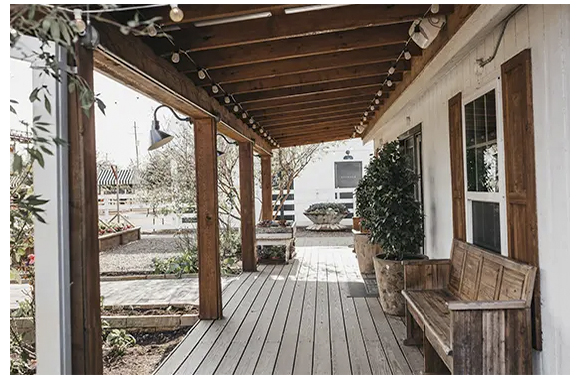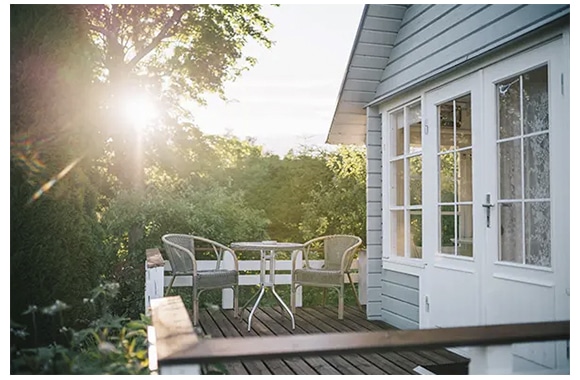Last updated: 1 May 2023
Use Stainless Steel Screws. Not Nails
When I first started building, and for the first few years as a builder, I used to nail the decking down using nails with an annular groove. However, nailing the deck has its downside, as it doesn’t hold the decking borders down over time. This is because the timber shrinks and expands, and eventually, the nails get pushed up on many old decks. You might have noticed this when walking on an old deck and feeling the heads of the nails below your feet. The little groove on the side of the nail isn’t enough to keep it in the timber. That’s why screws are a better option, as the threads on the top are for the decking, and the threads on the bottom are for the deck framing.

I recommend stainless steel it costs a little bit more but you’re not gonna get that bleeding out rusting. We usually use quite nice hardwood decking. You know it’s quite nice to look at so I like to use a subtle screw with a small head to take the attention away from the fixings.
Mark a Screw Line. But Leave No Pencil Marks.
And the second and final tip related to screws is markup it’s alone. But don’t forget to rub the pencil now. I think a telltale sign of an average deck is wonky fixings. So I like to get a straight edge out and mark the framing from one into another and draw little pencil marks along. The pencil line also lets you mark the distance from the edge of the boards and so you get consistently spaced screws. Oh yeah and don’t forget my dad’s golden decking advice which is no pencil marks. Keep an eraser or sandpaper with you and rub those suckers out.
Use Hardwood
If you want your deck to stand out if you want it to look beautiful build a hardwood deck. In recent years I have heard more debate around softwoods and hardwoods and which is better. I think hardwood is more durable it’s gonna take a knock a lot better than softwood. It’s more resistant to decay it has natural tannins and oils in it that um that. Pine for example relies a lot on the treatment.
Also, the hardwood that I use has a lot fewer knots in it. And knots can weaken decking a lot of cracks start from knots. Yeah, hardwood has a lot of benefits personally it’s also nicer to work with. But that doesn’t mean you should never use pine. The difference between pine and hardwood here and the price is quite a lot. If you’re building like an axis way or just some sort of decking that gets you from A to B maybe it’s an entrance to a back door. Then I would probably go with pine because it’s low cost and easy than hardwood.

Stain and Maintain
If you decide to start staining a deck you just got to know that you’re gonna be doing it quite often. Some people say two times a year. I usually recommend reapplying the stain once a year. I’m a fan of clear varnishes and stains. Rather than colored ones the colored ones are hard to maintain an even color over time as the deck wears in different degrees. So a clear stain would probably be the way to go.
That’s a great tip! Applying oil to the end grain of the deck boards is a simple yet effective way to prevent them from absorbing too much moisture, which can lead to cracking over time. It’s always important to take preventive measures to ensure the longevity of your deck.
Finish the Cut Edge With a Router
Finish the cut edge with a router along the cut end of the decking board. What that does is it rounds it off. It feels like a professional factory cut all the way around. I highly recommend doing it there. It’s another way to give it their professional look.
What is Under Your Deck?
Tip number six is the underrated tip. I think people don’t consider what is underneath their deck. If you’re going to close in the sides for example use some timber use decking but maybe leave a bigger gap. This allows the underneath of decking to ventilate and get some airflow in there. And that will lead to a longer life for the timber. Also, the ground beneath the deck should have some sort of weed mat.
At the very least the number of times I’ve pulled up decking and seen a forest beneath. It’s amazing how much light can get through those decking boards. So a bit of weed mat sometimes you can put polythene down if you want to. Another thing to consider would be drainage where’s all the water going. Yeah, think about what’s underneath the deck. Think about how earth and water are going to behave once it’s gone between the decking boards.
Hide the End Grain
And tip number seven is found a way to hide the ingrain. Over time if you look at the end of the decking board that’s where the moisture goes in there’s where the cracking starts it doesn’t look that good. I either like to use a fascia which is a board on the edge of the decking in the vertical position. I like to do a picture frame around the perimeter. The thing to consider with a picture frame finish is it requires a lot more framing.

Final Thoughts
When planning a deck, it’s important to consider both the size and the position. While many people may want to build the biggest deck possible, it’s important to consider the upkeep required, such as restaining. Additionally, you’ll want to consider the positioning of the deck in relation to the wind patterns in your area. For example, if you often experience strong afternoon breezes, you may want to position the deck in a way that maximizes shelter from the wind. Taking these factors into consideration will help ensure that your deck is a comfortable and enjoyable outdoor space for years to come.
So maybe think about where the windows? Think about if you could do a wind barrier? What kind of furniture do you want? Sometimes a roof is a good idea as well. There are so many things you can do.
If you have any questions please use the comment section below and I’ll be sure to keep it in mind. I hope that was useful.
Related post: Grooved Decking Should be Fitted Face Up or Down?




Leave a Reply